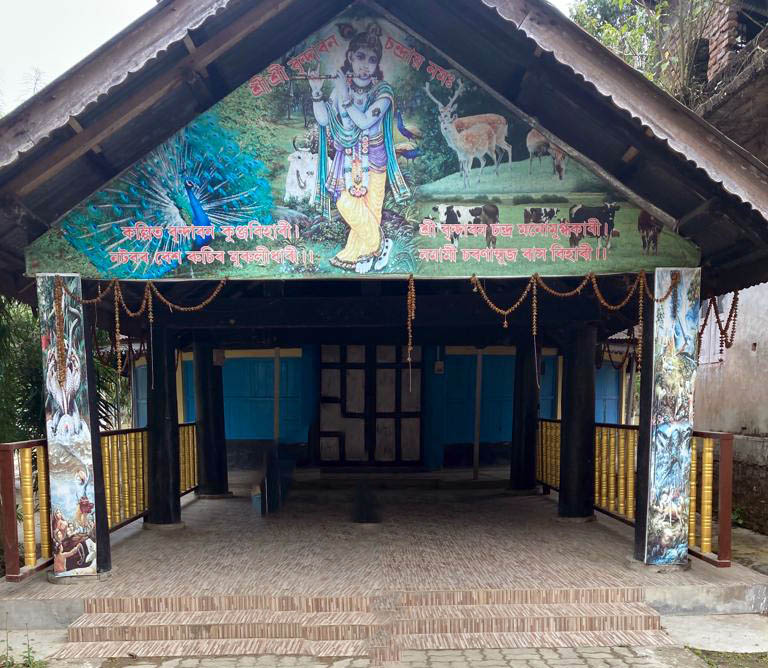Step into a monastery where centuries-old traditions are still alive, where monks preserve classical dance with devotion, and where spirituality and culture meet in everyday life.
Table of Contents
Why Visit Auniati Satra?
Sri Sri Auniati Satra is among the most important monasteries (satras) of Majuli. Established in 1653 by Niranjan Pathakdeva with the patronage of Ahom King Jayadhwaj Singha, it became one of the four raj satras (royal satras). Since then, it has remained a center of Vaishnavite spirituality and Assamese culture.
Even today, Auniati is active, housing monks (bhakats) who continue daily prayers, teach traditional arts, and welcome visitors curious to experience Majuli’s heritage.
What You’ll Experience
Monastic Life & Spiritual Practices
The satra follows the Vaishnavite teachings of Srimanta Sankardev, focusing on Bhakti (devotion) to Lord Krishna. Visitors can observe:
- Morning prayers and devotional songs (kirtan)
- Monks engaged in meditation and scripture study
- Peaceful courtyards with daily spiritual rhythms
Sattriya Dance & Cultural Traditions
Auniati is a living center of Sattriya dance, one of India’s eight classical dance forms. Monks also practice:
- Bhaona (theatre plays)
- Borgeet (devotional songs)
- Khol and Taal (traditional instruments)
While performances are not staged for tourists, you may see rehearsals or cultural programs during the day.
The Satra Museum
Auniati houses a small but rich museum, locally known as the Bhabdangona Museum, featuring:
- Ahom-era royal gifts and artifacts
- Ancient copper plates and manuscripts
- Ritual objects and traditional crafts
This collection provides a direct connection to Assam’s history and culture.
Festivals at Auniati Satra
- Janmashtami – birth anniversary of Lord Krishna, with prayers and songs.
- Raas Mahotsav – Majuli’s biggest cultural festival in November, with elaborate Bhaona plays and spiritual processions.
- Other annual Bhaona performances that draw devotees and cultural enthusiasts.
Practical Information
📍 Location: About 5 km west of Kamalabari, Majuli
⏰ Hours: 6:00 AM – 6:00 PM daily
🎟 Entry Fee: Free (donations welcome)
⏱ Suggested Visit Duration: 2–3 hours
🌸 Best Season: October – April (cool weather, cultural festivals)
Suggested Visit Schedule
- Morning (6–10 AM): Experience morning prayers and peaceful rituals
- Daytime (10 AM–4 PM): Possible dance or theatre rehearsals, museum visit
- Anytime: Explore museum collections and satra courtyards
How to Reach
- Take a ferry from Jorhat to Majuli (45 min – 1 hr across the Brahmaputra)
- From the ferry ghat, hire an auto-rickshaw, taxi, or bicycle
- The satra is 5 km from Kamalabari and easily accessible from homestays
Respect & Etiquette
- Dress modestly – this is an active monastery
- Remove shoes before entering prayer halls
- Seek permission before photographing rituals or monks
Combine with Other Satras
For a fuller picture of Majuli’s spiritual culture, combine Auniati with visits to nearby Kamalabari Satra and Dakhinpat Satra.
Why Auniati Satra Matters
Auniati Satra is not just a monument. It is a living institution where traditions are actively preserved. From Sattriya dance and Bhaona theatre to devotional music and spiritual learning, it continues to shape Assam’s identity today.
Visiting here offers a chance to connect with Assam’s heritage in its most authentic form – not as a show, but as living culture.
Planning your Majuli adventure? Explore our guides to homestays in Majuli and other satras to make the most of your trip.




